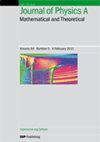Training quantum neural networks using the quantum information bottleneck method
IF 2.1
3区 物理与天体物理
Q2 PHYSICS, MATHEMATICAL
Journal of Physics A: Mathematical and Theoretical
Pub Date : 2024-08-27
DOI:10.1088/1751-8121/ad6daf
引用次数: 0
Abstract
We provide in this paper a concrete method for training a quantum neural network to maximize the relevant information about a property that is transmitted through the network. This is significant because it gives an operationally well founded quantity to optimize when training autoencoders for problems where the inputs and outputs are fully quantum. We provide a rigorous algorithm for computing the value of the quantum information bottleneck quantity within error利用量子信息瓶颈法训练量子神经网络
我们在本文中提供了一种训练量子神经网络的具体方法,以最大化通过网络传输的属性相关信息。这一点意义重大,因为它提供了一个操作上有理有据的数量,以便在训练输入和输出都是全量子的问题的自动编码器时进行优化。如果输入密度算子的频谱在δ > 0时支持{0} ⋃ [δ,1-δ] 且相关密度矩阵的核是不相交的,那么计算误差ε范围内的量子信息瓶颈量值只需O(log2(1/ϵ)+1/δ2)次查询。我们进一步提供了估算 QIB 函数导数的算法,表明在所需梯度步数为多项式的情况下,可以利用 QIB 量高效地训练量子神经网络。
本文章由计算机程序翻译,如有差异,请以英文原文为准。
求助全文
约1分钟内获得全文
求助全文
来源期刊
CiteScore
4.10
自引率
14.30%
发文量
542
审稿时长
1.9 months
期刊介绍:
Publishing 50 issues a year, Journal of Physics A: Mathematical and Theoretical is a major journal of theoretical physics reporting research on the mathematical structures that describe fundamental processes of the physical world and on the analytical, computational and numerical methods for exploring these structures.

 求助内容:
求助内容: 应助结果提醒方式:
应助结果提醒方式:


